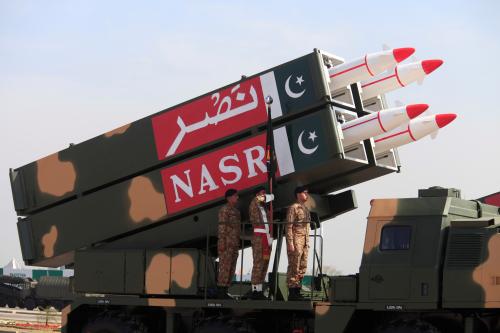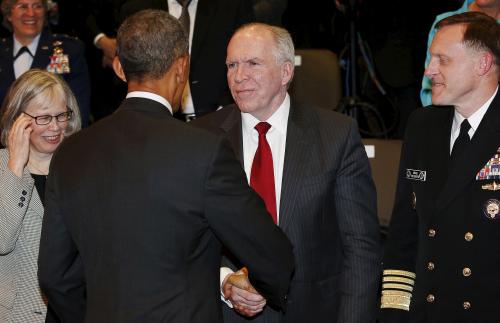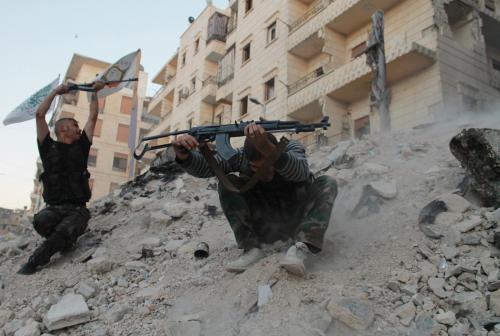The December 3 assessment by U.S. intelligence agencies that Iran “halted its nuclear weapons program” will have a significant effect on the international community’s efforts to deal with that program. By implying, misleadingly, that Iran is no longer actively trying to develop a nuclear weapons capability, the National Intelligence Estimate (NIE) has actually made it more likely that Iran will be able to do so without international opposition.
As numerous observers have already pointed out, the NIE’s judgment that Iran ended its nuclear weapons program in 2003 is misleading because it defines “nuclear weapons program” too narrowly. The document focuses only on Iran’s work on nuclear weapons design and covert uranium enrichment, whereas the international community’s greatest concern has always been Iran’s overt enrichment program, by far the greatest technical hurdle on the path to a nuclear weapons capability. (By contrast to enrichment and to the long-range ballistic missile capability that Iran is also pursuing, warhead design and weaponization are relatively fast and easy.) Moreover, and more importantly, the 2007 NIE actually confirms the judgment of a 2005 NIE that Iran will likely be technically capable of producing enough highly-enriched uranium for a nuclear weapon sometime during the 2010-2015 time frame, or potentially even as early as 2009. Finally, the 2007 NIE makes more clear than any previous intelligence document that until 2003 Iran was actively and illegally working on a nuclear warhead design, a conclusion that should actually lead to more concern and vigilance on the part of the international community, not less.
Despite all this, it seems clear that the NIE will facilitate Iran’s potential development of a nuclear weapon in several ways. First, the military option that the United States has been insisting must remain “on the table” is now “off the table.” That option may not have been very likely anyway, but there was always a chance that President Bush, who has shown his willingness to take risks and his determination to prevent proliferation in the past, would overrule potential objections and order a strike on Iran’s nuclear facilities. Doing so now that his intelligence community has publicly said Iran is not pursuing a nuclear weapons program is politically impossible. And if it is true, as suggested by the NIE, that the main reason Iran suspended its work on warhead design was fear of U.S. military action (Iran allegedly halted this part of its program just after the U.S. invasion of Iraq), then Iran may well feel freer to resume that work if it knows the U.S. will not use force.
Second, the NIE could make an Iranian nuclear weapon more likely by leading Iran’s emboldened leaders to accelerate its overt uranium enrichment program. Some observers have suggested that the NIE actually undercuts Iran’s hard-line President Mahmoud Ahmadinejad because he can no longer claim Iran is living under the threat of U.S. military force. That may be the case, but it is also the case that with the U.S. intelligence community now questioning Iran’s determination to build a nuclear weapon, Tehran can expand and accelerate its alleged civil nuclear program with impunity. Whereas in the previous climate an Iranian decision to go beyond its “pilot” enrichment plant (3,000 centrifuges) and move forward with an industrial-scale enrichment plant (50,000 centrifuges) might have raised red-flags, now it might not.
Finally and perhaps most importantly, the NIE undermines ongoing U.S. efforts to win support for additional economic and diplomatic sanctions designed to increase the costs to Iran of pursuing nuclear weapons. Whereas Washington’s main European allies have said the NIE would not change their position (indeed, it may actually be easier for the Europeans to support tougher sanctions now that the military option they wanted to distance themselves from is off the table), China and Russia have made it clear they see further action by the UN Security Council as unnecessary. Not directly threatened by the prospect of an Iranian nuclear weapon, and with increasing energy and economic interests in Iran (bilateral trade now at some $14 billion per year), China has been reluctant to support sanctions against Iran and the NIE gives Beijing a good reason not to act. Chinese diplomats had in fact announced only a few days prior to the NIE’s publication that they were prepared to move forward with further sanctions, but now argue that “things have changed.” Russia will be an even greater obstacle. Moscow seems even more concerned about denying Washington a diplomatic victory and preventing U.S. hegemony in the Middle East than it does about stopping the Iranian nuclear program, and will only be comforted by the NIE in its determination to avoid putting further sanctions on Iran.
What does all this mean for the future? Keeping in mind the possibility of major new developments that could change current trends (new intelligence that Iran actually has restarted its weaponization efforts, major setbacks in the Iranian enrichment program, a change in Iran’s leadership, or any of a number of other situation-changing events), the following scenario about the impact of the NIE is worth considering:
- The United States will take no major action on this issue before the end of Bush’s presidency in January 2009. Iran at that time will not have been able to enrich enough uranium to build a nuclear weapon, but its enrichment program will have been proceeding, allowing it to work toward that goal while improving its mastery of the process.
- Having been unable to persuade the other Security Council powers to impose serious sanctions on Iran, a new U.S. administration will seek direct negotiations with Iran, potentially offering it economic incentives, security assurances, and an agreed role in regional security in exchange for limits on and reassurances about its nuclear program.
- An emboldened Iranian leadership, determined to develop a nuclear weapons capability and in need of confrontation with the West to preserve its legitimacy at home, will reject such a dialogue with the United States, and continue to develop its enrichment program unabated.
- By the end of that next U.S. administration (2013), Iran will be capable of developing a nuclear weapon and perhaps willing to do so overtly, but the military option will not be realistic against a mature and dispersed enrichment program, and it will be too late for new international sanctions to have any effect. The result will be a nuclear-armed Iran, and the policy issue will be how to contain and deter it rather than how to prevent it.



Commentary
Op-edThe Iranian Nuclear Program after the National Intelligence Estimate
January 14, 2008